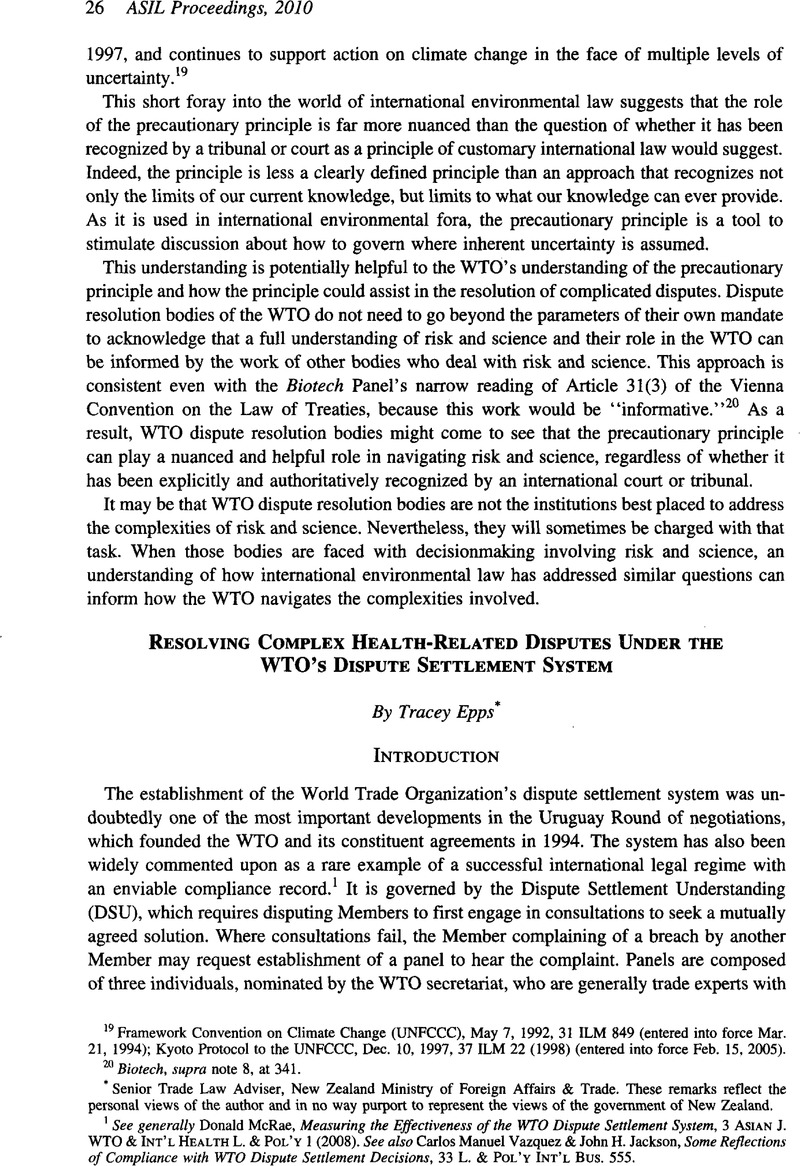No CrossRef data available.
Published online by Cambridge University Press: 28 February 2017

1 See generally McRae, Donald, Measuring the Effectiveness of the WTO Dispute Settlement System, 3 Asian J. WTO & Int’l Health L. & Pol’Y 1 (2008)Google Scholar. See also Vazquez, Carlos Manuel & Jackson, John H., Some Reflections of Compliance with WTO Dispute Settlement Decisions, 33 L. & Pol’y Int’l Bus. 555 Google Scholar.
2 WTO, Art. 11: Dispute Settlement Understanding, in WTO Analytical Index: Guide to WTO Law and Practice (2003) [hereinafter WTO].
3 The U.S. National Research Council, for example, has noted that “because our [scientific] knowledge is limited, conclusive direct evidence of a threat to human health is rare.” National Research Council, Risk Assessment in the Federal Government: Managing the Process 11 (1983).
4 See generally Fraiberg, Jeremy D. & Trebilcock, Michael J., Risk Regulation: Technocratic and Democratic Tools for Regulatory Reform, 43 McGill L.J. 835 (1998)Google Scholar; Weinburg, A.M., Science and its Limits: The Regulator’s Dilemma, in 27 De Minimus Risk 37 (Whipple, C. ed., 1987 Google Scholar).
5 One way in which the public may be influenced by protectionist interests is via the media. As Slovic notes, the news media “rather thoroughly document mishaps and threats occurring throughout the world.” Slovic, P., Perception of Risk, 236 Sci. 280, 280 (1987)CrossRefGoogle Scholar.
6 See Paul Slovic, the Perception of Risk (2000).
7 WTO, supra note 2, at art. 3.2.
8 Id. at art. 3.7
9 Agreement on the Application of Sanitary and Phytosanitary Measures, Apr. 15, 1994, 1867 Unts 493 [hereinafter SPS Agreement], at art. 12; Agreement on Technical Barriers to Trade, Apr. 12, 1979 [hereinafter TBT Agreement].
10 See, e.g., Howse, Robert, The WHO/WTO Study on Trade and Public Health: A Critical Assessment, 24 Risk Analysis 501, 507 (2004)CrossRefGoogle ScholarPubMed. Howse finds that the EC—Beef Hormones case is a good example of a case that was not appropriately resolved through WTO dispute settlement.
11 Pauwelyn, Joost, The Limits of Litigation: Americanization and Negotiation in the Settlement of WTO Disputes, 19 OHIO St. J. On Disp. Resol. 121, 132 (2003)Google Scholar.
12 See, e.g., Howse, supra note 10, at 507.
13 Dispute settlement is more transparent than the alternatives, in the sense that panel and Appellate Body reports are public documents, amicus curiae briefs are generally allowed, and, increasingly, panel hearings are opened to members of the public.